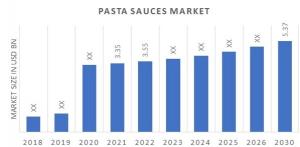Pasta Sauces Market to Hit USD 5.37 Billion by 2032 at 6.10% CAGR Driven by Demand for Non-GMO Ingredients
Pasta Sauces Market, By Product Type, Packaging Type, Distribution Channel, By Regional
NEW YORK, NY, UNITED STATES, August 6, 2025 /EINPresswire.com/ -- The global Pasta Sauces Market is poised for robust growth, projected to reach USD 5.37 billion by 2032, expanding at a compound annual growth rate (CAGR) of 6.10% from 2023 to 2032. This surge is primarily driven by shifting consumer preferences toward healthier, more transparent food choices, particularly the increasing demand for non-GMO (genetically modified organism) ingredients.In recent years, consumers across North America, Europe, and Asia-Pacific have exhibited a stronger inclination toward organic, clean-label, and non-GMO products in their daily diets. Pasta sauces, a staple in global cuisine, have become a focal point for food producers adapting to this health-conscious trend. The growing aversion to artificial additives and genetically modified ingredients has spurred innovation among key market players, who are now introducing pasta sauces made with organic tomatoes, natural herbs, and sustainable ingredients.
Non-GMO Trends Reshape Consumer Expectations
The expanding base of health-aware consumers is reshaping the pasta sauces landscape. More shoppers are reading ingredient labels and opting for products that support sustainable farming practices and exclude GMOs, synthetic preservatives, and artificial flavorings. This clean-label movement is being reinforced by mounting evidence linking GMOs to potential health and environmental concerns, prompting shoppers to seek alternatives that align with their values.
Manufacturers have responded swiftly by reformulating products, launching new sauce lines that meet non-GMO certification standards, and highlighting transparent sourcing practices. In the competitive retail environment, brands that emphasize non-GMO and organic ingredients are gaining an edge, particularly in premium and natural food segments.
Request Free Sample - Obtain a complimentary sample of our report to assess its quality and relevance to your: https://www.marketresearchfuture.com/sample_request/7413
Innovation and Product Diversification Support Market Momentum
Product innovation remains a core driver of market growth. From traditional marinara and Alfredo to exotic pesto, arrabbiata, and vegan-friendly options, pasta sauce makers are expanding their offerings to cater to diverse dietary needs and regional flavor profiles. The rise of plant-based diets has further propelled the demand for dairy-free and meatless pasta sauces, with brands focusing on clean, wholesome formulations that deliver both taste and nutritional value.
In addition, the emergence of functional sauces—infused with superfoods like turmeric, chia seeds, or probiotics—reflects a broader consumer interest in foods that contribute to overall wellness. These functional pasta sauces, often marketed as part of a healthy lifestyle, are gaining popularity among younger consumers and health-conscious households.
E-commerce and DTC Channels Accelerate Sales Growth
Online retailing and direct-to-consumer (DTC) platforms have significantly contributed to the pasta sauces market's growth trajectory. The convenience of ordering groceries online, coupled with targeted marketing and subscription models, has enabled smaller and niche brands to reach wider audiences. Many consumers are now discovering unique, artisanal pasta sauces through online channels, reinforcing demand for premium, non-GMO offerings.
Moreover, digital platforms allow manufacturers to communicate their value propositions more effectively. Through online product descriptions, certification badges, and storytelling, brands can showcase their commitment to quality, sustainability, and health-conscious production—attributes that strongly appeal to modern consumers.
Browse Report - Explore the report's contents, sections, and key insights by browsing through its detailed information: https://www.marketresearchfuture.com/reports/pasta-sauces-market-7413
Key Player
Mizkan Co.(Japan), Barilla S.p.A.(Italy), Mars Incorporated (US), ConAgra Foods Inc.(US), The Kraft Heinz Company (US), Amy's Kitchen (US), Newman Own Co.(US), B&G Foods Holdings Corp.(US), Premier Foods PLC (UK), Campbell Soup Company (US)
North America and Europe Remain Dominant Markets
Geographically, North America and Europe remain the dominant regions in the pasta sauces market, accounting for a significant share of global revenue. In these mature markets, consumer awareness of food quality, transparency, and ethical sourcing is especially high. Leading brands in the U.S., Canada, Italy, Germany, and the U.K. are leveraging these trends to boost sales, often launching new product lines that align with dietary preferences such as gluten-free, keto, and paleo.
The Asia-Pacific region, meanwhile, is emerging as a high-growth market, particularly in urban centers across China, Japan, India, and Southeast Asia. As Western-style eating habits gain popularity and disposable incomes rise, consumers in these countries are increasingly seeking convenient, high-quality pasta sauces that deliver global flavors without compromising on health and safety.
Sustainability and Ethical Sourcing Add Long-Term Value
Beyond ingredient transparency, sustainability and ethical sourcing have become key pillars for long-term brand differentiation. Consumers are paying more attention to how food is grown, processed, and packaged. Brands that emphasize environmentally responsible farming, fair labor practices, and recyclable packaging are earning consumer trust and loyalty.
Several major players are already investing in regenerative agriculture, water-saving production methods, and carbon footprint reduction initiatives. As climate change and ecological concerns continue to influence consumer habits, these efforts are likely to strengthen market positions and contribute to sustained growth.
Table of Contents
EXECUTIVE SUMMARY
MARKET INTRODUCTION
RESEARCH METHODOLOGY
MARKET DYNAMICS
MARKET FACTOR ANALYSIS….
Discover More Research on Food and Beverage Industry by Market Research Future:
Monk Fruit Sweetener Market
https://www.marketresearchfuture.com/reports/monk-fruit-sweetener-market-42968
Moringa Tea Market
https://www.marketresearchfuture.com/reports/moringa-tea-market-38605
Mustard Flour Market
https://www.marketresearchfuture.com/reports/mustard-flour-market-35614
Mycotoxin Testing Market
https://www.marketresearchfuture.com/reports/mycotoxin-testing-market-41661
Non Basmati Rice Market
https://www.marketresearchfuture.com/reports/non-basmati-rice-market-41665
Non Carbonated Soft Drinks Market
https://www.marketresearchfuture.com/reports/non-carbonated-soft-drinks-market-23696
Oral Clinical Nutrition Supplement Market
https://www.marketresearchfuture.com/reports/oral-clinical-nutrition-supplement-market-26620
Sagar Kadam
Market Research Future
+1 628-258-0071
email us here
Visit us on social media:
LinkedIn
Facebook
X
Legal Disclaimer:
EIN Presswire provides this news content "as is" without warranty of any kind. We do not accept any responsibility or liability for the accuracy, content, images, videos, licenses, completeness, legality, or reliability of the information contained in this article. If you have any complaints or copyright issues related to this article, kindly contact the author above.
A' International Engineering, Construction and Infrastructure Design Awards Call for Nominations
Virtual Reality Gaming Set for Steady Growth with 4.7% CAGR by 2032
Autonomous Vehicles Market Poised for Explosive Growth, Valued at USD 258.69 Billion by 2035
Więcej ważnych informacji
 Jedynka Newserii
Jedynka Newserii

 Jedynka Newserii
Jedynka Newserii

Polityka

D. Joński: Nie wiemy, co zrobi Rosja za dwa–trzy lata. Według duńskiego wywiadu może zaatakować kraje nadbałtyckie i musimy być na to gotowi
Zdecydowana większość krajów unijnych wskazuje na potrzebę wzmocnienia zdolności obronnych Europy w obliczu coraz bardziej złożonego geopolitycznego tła. Wywiady zachodnich państw wskazują, że Rosja może rozpocząć konfrontację z NATO jeszcze przed 2030 rokiem. Biała księga w sprawie obronności europejskiej „Gotowość 2030” zakłada m.in. ochronę granic lądowych, powietrznych i morskich UE, a sztandarowym projektem ma być Tarcza Wschód. – W budzeniu Europy duże zasługi ma polska prezydencja – ocenia europoseł Dariusz Joński.
Transport
Duże magazyny energii przyspieszą rozwój transportu niskoemisyjnego w Europie. Przyszłością może być wodór służący jako paliwo i nośnik energii

Zmiany w europejskim transporcie przyspieszają. Trendem jest elektromobilność, zwłaszcza w ramach logistyki „ostatniej mili”. Jednocześnie jednak udział samochodów w pełni elektrycznych w polskich firmach spadł z 18 do 12 proc., co wpisuje się w szerszy europejski trend spowolnienia elektromobilności. Główne bariery to ograniczona liczba publicznych stacji ładowania, wysoka cena pojazdów i brak dostępu do odpowiedniej infrastruktury. – Potrzebne są odpowiednio duże magazyny taniej energii. Przyszłością przede wszystkim jest wodór – ocenia Andrzej Gemra z Renault Group.
Infrastruktura
W Polsce w obiektach zabytkowych wciąż brakuje nowoczesnych rozwiązań przeciwpożarowych. Potrzebna jest większa elastyczność w stosowaniu przepisów

Pogodzenie interesów konserwatorów, projektantów, inwestorów, rzeczoznawców i służby ochrony pożarowej stanowi jedno z największych wyzwań w zakresie ochrony przeciwpożarowej obiektów konserwatorskich. Pożary zabytków takich jak m.in. katedra Notre-Dame w Paryżu przyczyniają się do wprowadzania nowatorskich rozwiązań technicznych w zakresie ochrony przeciwpożarowej. W Polsce obowiązuje już konieczność instalacji systemów detekcji. Inwestorzy często jednak rezygnują z realizacji projektów dotyczących obiektów zabytkowych z uwagi na zmieniające się i coraz bardziej restrykcyjne przepisy czy też względy ekonomiczne.
Partner serwisu
Szkolenia

Akademia Newserii
Akademia Newserii to projekt, w ramach którego najlepsi polscy dziennikarze biznesowi, giełdowi oraz lifestylowi, a także szkoleniowcy z wieloletnim doświadczeniem dzielą się swoją wiedzą nt. pracy z mediami.




![Nestlé w Polsce podsumowuje wpływ na krajową gospodarkę. Firma wygenerowała 0,6 proc. polskiego PKB [DEPESZA]](https://www.newseria.pl/files/1097841585/fabryka-nesquik_1,w_85,r_png,_small.png)




.gif)

 |
| |
| |
|